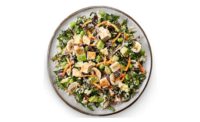Savvy Savory Trends
Savory items are almost always a menu staple—from main dishes to side dishes and appetizers. Today’s menus reflect consumer preferences, and sometimes their demands, for fresh/sustainable, meatless or portable menu items. From non-traditional takes on comfort foods to innovative new presentations, restaurants all over the U.S. (and beyond) are embracing the needs of today’s consumers and make eating out an adventure.
(Editor's note: See chart below for Technomic's assessment of the most popular savory flavors on the nation's menus, July through December 2009.)
More Than Meat and Potatoes--Portable Progress
Food product manufacturers have long known that portability is a huge selling point, but lately, that concept is making it big in restaurants, as well. Portable fare is not new, of course. The sandwich, that age-old invention by an Earl with a gambling problem, has held its place of honor on the menu for the past century.
One new (yet old) menu item with the benefit of hand-held portability is the hand pie. These single-serving pastries, sweet or savory, baked or fried, are showing up on menus all over the country. Known as meat pies or pasties, the hand pie can trace its origin back to 19th-century England, where Cornish miners took them down as a convenient lunch. The pastry casing served to keep the filling warm and dirt-free. The edges served as an easy way to hold the pie while eating. When the Cornish immigrated to northern Michigan, they brought the tradition to the United States.
If one travels to the Upper Peninsula of Michigan or northern Wisconsin, pasties are common menu fare, with some pasty restaurants even selling them frozen, to be heated up at home. Fillings at the Pasty Corner, in Iron River, Mich., include the common ground beef mixture (meat, potato, onions) and also have a variety with rutabaga added to the meat mixture. While proud of the past, the small restaurant has also moved with the times, to include vegetable-only pasties (potato, broccoli, cauliflower, carrots, onions, cheese) and even “pizza” pasties, filled with sausage and pepperoni, red sauce and mozzarella cheese. Breakfast pasties consist of scrambled eggs, potatoes, ham, onions and cheese.
Fillings for hand pies are infinitely flexible; typically, they reflect regional differences.In Portland, Ore., (The Oregonian, May 4, 2010), Chris Powell and his wife, Sarah Curtis-Fawley, opened the Pacific Pie Co. shop, which serves single-serving classic beef pies. Hailing from Australia, the couple says they missed the meat pies from home, and a small sideline turned into a business. At Little Pots & Pies, also in Portland, Kris Pennella turns out 1,200-1,500 hand pies in any given week, using local ingredients for the fillings. Curried butternut squash is popular, in season, but she also cites roasted tomato, caramelized onion and goat cheese as other popular fillings with endless combinations. Using locally grown ingredients satisfies many customers’ desire for local sourcing.
And Now Presenting
That quintessentially Southern custom of “putting up” foods in Mason and Weck jars just went big-time. Food jars are not just for pickling anymore--savvy chefs in all parts of the U.S. are using them as easy, cost-effective ways to get food to the table. Potted meals, or food in jars, claim an entire section on the menu of Bacchanalia, Star Provisions, Floataway Café, in Atlanta (Atlanta Journal-Constitution, April 27, 2010). Chef-owner Anne Quatrano claims, “Jars make easy traveling kits for food, provide a pretty presentation and are extremely economical. Jars cost less than plates, too.”
Almost the entire meal can be served in jars--from pickled shrimp to seasonal vegetables to potted meat. Foods can be layered, giving the customer a true look at what they are eating. Layered shrimp salad or potted chicken liver makes presentation key and also gives restaurant patrons a little taste of home--especially if their grandmothers ever put up corn, okra or fruit, making this a restaurant trend worth preserving.
Vegan and Counting
Vegetarian fare has never really been associated with fine dining, but a new generation of vegans, along with the trend in general of eating less meat, is causing a boost in veggie eateries and menu items. Thus, the number of higher-end vegetarian restaurants is fast rising, prompted in part by the innovation of leading chefs, but also due to an interest in healthier and greener lifestyles.
Many believe carnivorous cuisine is not good for the environment, and in the case of vegetarian eateries, the economy may actually be aiding and abetting their ascension. “Meat reducers,” as they are called in the U.K., are a growing group of food enthusiasts who are at least partly vegetarian.
A gourmet vegetarian restaurant reduces the temptation to order steak and leaves off the problem of discomfort associated with seeing a roast at the next table--something true vegetarians would find unappetizing. "Vegetarian couples do not want a special date marred by the sight of foie gras on the menu nor the aroma of roast lamb wafting from the next table," says Alex Bourke, founder and compiler of the Vegetarian Guides to Meat-free Eating in Britain, as reported in The Guardian, April 30, 2010.
The situation is much the same on this side of the Pond. Vegetarians are often not happy using cutlery or plates that are used for meat. Otarian, a new fast-casual restaurant chain, is set to have a big impact on the New York City food scene, with the opening of the first of two locations in the U.S. this spring, and a third one later this year. Otarian is reported to be the first global chain to carbon-footprint all of its menu items according to internationally recognized standards and will include the carbon footprint of every dish on its menu. The chain is built on a sustainable platform, based on the principals of vegetarianism. pf
Getting the Flavor
Most popular savory flavors on the nation's menus, July through December 2009.
| Rank | Flavor |
|---|---|
| 1 | Tomato |
| 2 | Onion |
| 3 | Pepper |
| 4 | Bacon |
| 5 | Garlic |
| 6 | Cheddar |
| 7 | Barbecue |
| 8 | Chili |
| 9 | Jalapeno |
| 10 | Chipotle |
| 11 | Buffalo |
| 12 | Cajun |
| 13 | Ginger |
| 14 | Hickory |
| 15 | Teriyaki |
| 16 | Vinegar |
| 17 | Mesquite |
| 18 | Wasabi |
| 19 | Miso |
| 20 | Rosemary |
Base: 27,370 entrees on 677 restaurant menus in the US., July-December 2009
Source: Technomic MenuMonitor
Other Resources
* Grilling
* Get Saucy!
* Top 10 Menu Trends to Inspire Prepared Food Formulations
* On-trend Flavors for Today's Consumers
From the June 7, 2010, Prepared Foods E-dition
Looking for a reprint of this article?
From high-res PDFs to custom plaques, order your copy today!




